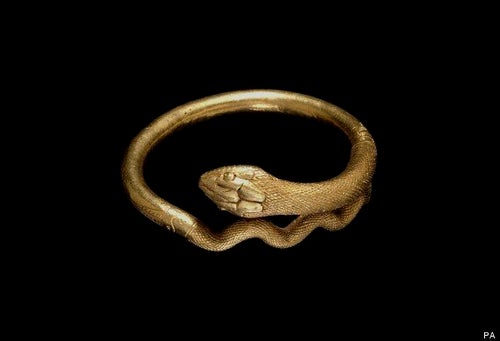Dozens of objects recovered from the ruins of Roman cities Pompeii and Herculaneum will go on show outside Italy for the first time at a new exhibition at the British Museum.
The two cities on the Bay of Naples were wiped out by the eruption of Mount Vesuvius in 79 AD.
The show will feature objects found in their ruins including jewellery, carbonised food and a baby's crib that still rocks on its curved runners.


Gold bracelet in the form of a coiled snake, 1st Century AD
Curator Paul Roberts said the 250 objects would illustrate the domestic lives of the population and show the "different halves of this amazing story".
He said: "These are not extraordinary cities, they die in an extraordinary way, but they are ordinary cities in Roman terms.
"That's why they are so important because we can look at them and say we have a pretty good idea what was going on in other Roman cities."
Mr Roberts said the 400 to 500 centigrade volcanic avalanche that buried Herculaneum had preserved many objects including furniture and food.
He said: "It was buried in a different way from Pompeii and the effect of that as this cloud of superheated gas and debris swirled around the houses of Herculaneum it carbonised, it turned into charcoal wood, leather and even food."
Six pieces of carbonised furniture, including the crib, will be lent to the British Museum in what Mr Roberts said was "a world first".
He said there would also be "a loaf of bread that was put in the oven in AD79 and came out in the 1930s" complete with the namestamp of the slave who baked it.
Other exhibits include peppercorns rescued from the drains, carbonised figs, a lamp and wall paintings.
Also on show will be the body casts of six people, including a family of two adults and two children who died huddled together under the steps of their villa, and a pet dog.
Mr Roberts said: "The exhibition isn't about death, you had to have the death of the cities in order to bring them to life again, but the exhibition is all about the life of these people."
The exhibition, which is sponsored by Goldman Sachs, is a collaboration with the Archaeological Superintendency of Naples and Pompeii, which is responsible for the remains of the two cities.
The exhibition runs from 28 March 29 September next year at the London museum.
Meanwhile, elsewhere on Culture this week...